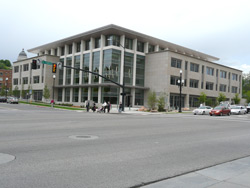 First – note that this blog is not about the Family History Library in Salt Lake City. Instead, it is about the new LDS Church History Library, located just over a block to the east on North Temple (next to the Assembly Hall – and across the street from the LDS Church Office Building).
First – note that this blog is not about the Family History Library in Salt Lake City. Instead, it is about the new LDS Church History Library, located just over a block to the east on North Temple (next to the Assembly Hall – and across the street from the LDS Church Office Building).
The new library is set to open on June 22 – but over the last few days, tours of the facility have been conducted by the Library staff – allowing the public to see areas of the building that will be off-limits once the building is open to the public. I had the opportunity to tour the facility on Wednesday, June 17, with a group of APG Salt Lake City, Utah Chapter members. I was at the library for a couple hours and got the chance to see how useful this facility will be for genealogists. Yes – the library deals with LDS church history, but within the myriad documents they hold is a lot of genealogy, as well as Western history materials. 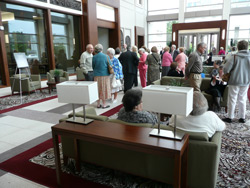
I’ve posted an album of photos that I took in the library that you might want to check out.
The Church History Library houses the following collections:
- 270,000 books, pamphlets, magazine, manuals, etc. (if stacked on top of each other, the books would be as tall as Mt. McKinley in Alaska.)
- 500,000 historic photographs, posters, maps, etc.
- 23,000 audio and video recording
- 120,000 local histories for LDS Church units
- 150,000 journals diaries, papers, and manuscripts
- 20,000 rolls of microfilm
- 3.5 million patriarchal blessings for LDS Church members
Following are a few facts about the library that you might find interesting. I got the information from posters displayed around the room for the tours, the Deseret News and from the tour guides.
In 1900, there were only 10 employees in the LDS Office of the Church Historian. There are now 234 people.
The land the Church History Library sits on was originally owned by Heber C. Kimball, First Counselor to President Brigham Young. The land has been occupied by homes, a school, a blacksmith shop, a pharmacy, a cafe, an ice-cream shop, a dance academy, a bowling alley, an advertising agency and a missionary training center.
Plans for the Church History Library were announced on April 20, 2005 and ground was broken on October 11, 2005. A new library has been discussed for decades – and is now a reality.
Over 300 people helped move the historical collections from the Church Office Building to the Church History Library. This included employees, missionaries and movers from Bailey’s Moving and Storage. The ages of the folks ranged from 19 to 91. The move took over 10,000 hours.
The 230,000 square-foot Church History Library contains 179 years worth of history. Everything from pages of the Book of Mormon manuscript to advanced digital technology.
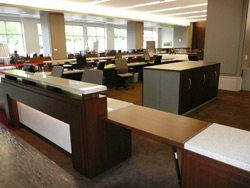 The Circulation staff will retrieve and return material to the closed stacks and Granite Mountain Records Vault. They will track the location of items, house new acquisitions, maintain proper a storage environment, and identify conservation issues & interact with the conservations teams.
The Circulation staff will retrieve and return material to the closed stacks and Granite Mountain Records Vault. They will track the location of items, house new acquisitions, maintain proper a storage environment, and identify conservation issues & interact with the conservations teams.
Collections of LDS-related historical materials such as books and papers are dealt with by staff members who read, transcribe, authenticate, and catalog these materials so they can be used by patrons in the library or on the Internet.
Many of the fragile historic documents found within the collections have been digitized and may be accessed on computers found within the public research room of the library. A number of microfilm readers are also found there.
There are twelve high-density storage vaults within the library. Most are kept at 55 degrees, with 35% humidity. However, two vaults holding 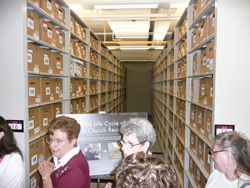 photographs and motion pictures are kept at minus four degrees Fahrenheit. Items from these vaults require removal and thawing at 55 degrees for 24 hours prior to handling. The two freezer units are equivalent to 3,100 home freezers. The archival storage units contain 21 miles of shelving. Most vaults are for long-term storage. However, we visited one vault that is used for short lifespan items. These documents most likely will not be kept over 10 years, with only about 5% of the materials to be kept long-term. One of the vaults (each capable of holding a full tennis court!) currently has nothing in it. None of the vaults are full, so it should be several decades before storage space becomes any kind of an issue. It’s said that the cold storage vaults in the library could hold 3.2 million ice cream sandwiches on the shelves. No plans are in place to use the vaults for this purpose.
photographs and motion pictures are kept at minus four degrees Fahrenheit. Items from these vaults require removal and thawing at 55 degrees for 24 hours prior to handling. The two freezer units are equivalent to 3,100 home freezers. The archival storage units contain 21 miles of shelving. Most vaults are for long-term storage. However, we visited one vault that is used for short lifespan items. These documents most likely will not be kept over 10 years, with only about 5% of the materials to be kept long-term. One of the vaults (each capable of holding a full tennis court!) currently has nothing in it. None of the vaults are full, so it should be several decades before storage space becomes any kind of an issue. It’s said that the cold storage vaults in the library could hold 3.2 million ice cream sandwiches on the shelves. No plans are in place to use the vaults for this purpose.
The library contains a very sophisticated air filtration system, helping to preserve its contents. The system rids the air of sulfur dioxide, nitrous oxide, soot and such impurities.
That plan is that over time, more and more historic digitized material found only in the library will be available over the Internet.
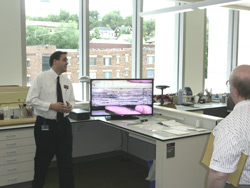 Six thousand published items are added to the Church History Library collection each year. Five hundred to 700 archival collections are added to the Library each year.
Six thousand published items are added to the Church History Library collection each year. Five hundred to 700 archival collections are added to the Library each year.
Five hundred missionaries work in the LDS Church History Department.
The James Moyle Oral History Program is a method of documenting church history through interviews with first-generation Latter-day Saints or others who have made a significant contribution to the growth and development of the Church. Since 1972, the church has recorded over 5,000 oral histories in 65 countries.
Each year, Church missions, stakes and districts submit an annual history to the Church History Library. Each annual history contains a list of local officers, details about the growth of the Church in that area, and stories of faith and service of Latter-day Saints.
There are 40,500 shelves in the Library, equaling 28 miles (21 miles of which are within the vaults, as mentioned above).
Each of the building’s 40,500 storage shelves has an individual identification label, enabling the Church History Department to know the location of every item in the collection.
All the recycled paper from the downtown LDS Church campus will come through the Church History Library – that’s 4.5 tons of paper each month! 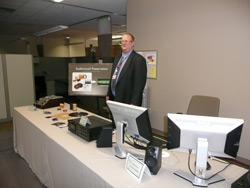
The Church History Library collects materials related to the growth and development of the LDS Church and its members worldwide, including Church records, personal letters and papers, diaries, photographs, etc. Church representatives in the New Acquisitions Intake Unit are happy to discuss the acquisition and archiving of these types of materials with anyone.
The advance of technology means that a number of processes are required to preserve the records. Everything from recordings on wax cylinders, to wire, to tape, to acetate, to digital – as well as paper – must be preserved.
Microfilm is still the standard when it comes to record preservation. Digital recording of photographs, sound, and documents may make distribution easier, but it’s not archival. One of the archivists on the tour recommended we rerecord all homemade digital records every three to five years – just to make sure we don’t lose data.
The Church History Library is located at 15 East North Temple Street in Salt Lake City, Utah. It will be dedicated on June 20. The Reference & Research Assistance phone number is 1-801-240-2272. Email: churchhistorylibrary@ldschurch.org
Beginning on Monday, June 22, 2009, the library will be open: Monday, Tuesday, Wednesday and Friday from 9 am to 5 pm; Thursday from 9 am to 9 pm; and Saturday from 9 am to 2 pm.
Excellent post by someone who’s been behind the scenes and took notes! Thank you, Leland.
Prior to 1929 in the Juvenile Instructor my Mother wrote an article on prayer. The article was accepted and printed . I woulld appreciate if the article can be found and copied and sent to me. My address is:Robert Jacobus 10361 #1012, Orlando, Florida, 32825. Thanking you in advance for you efforts.
Gratefully yours,
Robert Jacobus
Greetings. Thank you for sharing that. I am curious, is the James Moyle Oral History Program something that is accessible? My mission president, President Steven Mecham, was recorded regarding the opening of missionary work in Russian from our Finland Helsinki Mission. How would one go about listening to that interview?
Thanks,
Ralph
I have items the church might be interested in. Whom do I contact? They are from about 1840 in the Nauvoo area.
For Barbara Packam:
Contact Brad Westwood at the Church History Library. His e-mail is brad.westwood@ldschurch.org